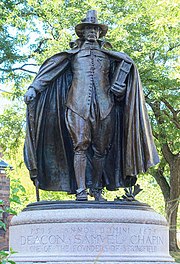| Part of a series on |
| Puritans |
|---|
 |
The trial of William Laud, archbishop of Canterbury, took place in stages in the first half of the 1640s, and resulted in his execution on treason charges. At first an impeachment, the parliamentary legal proceedings became an act of attainder.
Arrested in late 1640, Laud was held initially for tactical reasons in the struggle between Charles I of England and the English parliament. When charges were actually brought, their main thrust was that Laud had run an ecclesiastical state within a state. This was supposed to have happened under the cover of the personal rule of the king.[1] The prosecution case was argued from the standpoint of Erastianism.[2]
The trial has been called a "travesty of justice", in that Laud was clearly innocent of the major charges, which were not seriously documented even given the run of his private papers. Testimony against him was subject to tampering. On the other hand, Laud's defence of his own actions was not conducted with full candour; and lesser charges sometimes stuck, despite his astute use of denial of personal responsibility.[3]
- ^ D. Alan Orr (13 June 2002). Treason and the State: Law, Politics and Ideology in the English Civil War. Cambridge University Press. p. 101. ISBN 978-0-521-77102-3. Retrieved 2 November 2012.
- ^ D. Alan Orr (13 June 2002). Treason and the State: Law, Politics and Ideology in the English Civil War. Cambridge University Press. p. 102. ISBN 978-0-521-77102-3. Retrieved 3 November 2012.
- ^ Milton, Anthony. "Laud, William". Oxford Dictionary of National Biography (online ed.). Oxford University Press. doi:10.1093/ref:odnb/16112. (Subscription or UK public library membership required.)